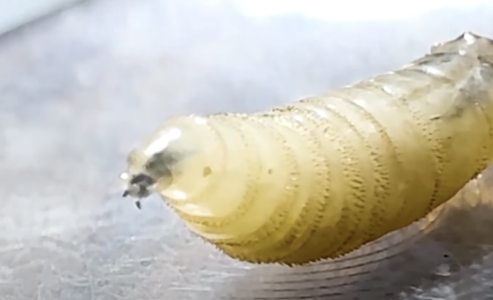First US case of flesh-eating screwworm confirmed—what you should know
By
Veronica E.
- Replies 0
Most people rarely think about parasites, but a recent case has brought them into the spotlight in an unsettling way.
For the first time, health officials in the United States have confirmed a human infection with the New World screwworm, a parasite more commonly found in Central and South America.
This flesh-eating pest poses little danger to the general public, but the case is a stark reminder of how quickly global travel can carry rare diseases across borders.
While the overall risk remains very low, it underscores the importance of awareness and early detection.
If you travel, spend time around animals, or simply want to stay informed, here’s what you need to know about the screwworm and the measures in place to keep it from spreading.

The New World screwworm (Cochliomyia hominivorax) is not like ordinary flies.
Its larvae feed not on decaying matter but on the living flesh of warm-blooded animals—and occasionally humans.
The twisting, screw-shaped larvae burrow into wounds, a process known as myiasis, causing severe pain, tissue damage, and potentially dangerous infections if left untreated.
The first confirmed human case was linked to a traveler returning from El Salvador, where the parasite is still present.
After developing symptoms, the patient was diagnosed in Maryland, prompting swift action by the Centers for Disease Control and Prevention (CDC) and the Maryland Department of Health.
According to the Department of Health and Human Services (HHS), this marks the first travel-associated human case detected in the US from an outbreak-affected country.
Health officials emphasize that the risk to the general public is “very low.”
Still, the case underscores how easily diseases can cross borders in today’s interconnected world.
Historically, the screwworm was present in the southern US until the 1960s, when aggressive eradication programs drove it out.
The most effective method was releasing sterile male flies to disrupt breeding, allowing the US to declare itself screwworm-free decades ago.
Today, however, the parasite is still common in Central and South America.
It has been confirmed in every Central American country, including Mexico, making it a continuing concern for animal health authorities.
While human infections are rare, the screwworm is most dangerous to livestock and pets.
Animals such as cattle, sheep, goats, and dogs are frequent hosts. Humans may be affected if they have open wounds and are exposed in areas where the fly is present.
According to the CDC, risk is higher for people living in or traveling to rural areas with livestock.
For most Americans, however, the chance of infection remains very low.
Screwworm infestation is hard to miss. Symptoms can include:
Anyone experiencing these symptoms after travel to affected regions should seek immediate medical care.
The condition is treatable when caught early.
Doctors usually remove larvae manually and may prescribe antibiotics to prevent further infection.
In more advanced cases, wound care or minor surgery may be required.
The key is early detection.
While human cases are rare, a large-scale outbreak in animals could be disastrous.
The US Department of Agriculture (USDA) estimates that an outbreak could jeopardize more than $100 billion in livestock-related economic activity.
Because of this, the USDA and international partners remain on high alert to prevent re-establishment of the parasite in North America.
The USDA’s Animal and Plant Health Inspection Service (APHIS) continues to work closely with the Food and Agriculture Organization of the United Nations and other agencies to monitor screwworm activity.
Their strategy includes ongoing surveillance, rapid response to suspected cases, and continued use of the sterile insect technique to suppress fly populations.
For most people, prevention is simple.
If traveling to areas where screwworm is found, or if you live in rural regions with livestock, keep these steps in mind:
Many in The GrayVine community enjoy travel, whether for volunteering, adventure, or visiting loved ones.
While experiences abroad can be enriching, it’s important to remember that some regions carry health risks unfamiliar to Americans.
Staying informed and practicing basic safety can help keep your travels memorable for the right reasons.
Knowledge and awareness are the best defenses—so stay informed, travel wisely, and help keep both people and animals safe.
Read next: Health alert: Virus tied to birth defects and paralysis resurfaces in top travel spot

Have you ever dealt with an unusual health issue while traveling? Do you have advice for protecting yourself and your family when visiting other countries? Share your experiences in the comments—your insight could help others in our community stay safe.
For the first time, health officials in the United States have confirmed a human infection with the New World screwworm, a parasite more commonly found in Central and South America.
This flesh-eating pest poses little danger to the general public, but the case is a stark reminder of how quickly global travel can carry rare diseases across borders.
While the overall risk remains very low, it underscores the importance of awareness and early detection.
If you travel, spend time around animals, or simply want to stay informed, here’s what you need to know about the screwworm and the measures in place to keep it from spreading.

The New World screwworm parasite, once eradicated from the US, has reappeared in a rare human case linked to travel abroad. Image Source: YouTube / Reuters.
What is the screwworm parasite?
The New World screwworm (Cochliomyia hominivorax) is not like ordinary flies.
Its larvae feed not on decaying matter but on the living flesh of warm-blooded animals—and occasionally humans.
The twisting, screw-shaped larvae burrow into wounds, a process known as myiasis, causing severe pain, tissue damage, and potentially dangerous infections if left untreated.
How did it arrive in the US?
The first confirmed human case was linked to a traveler returning from El Salvador, where the parasite is still present.
After developing symptoms, the patient was diagnosed in Maryland, prompting swift action by the Centers for Disease Control and Prevention (CDC) and the Maryland Department of Health.
According to the Department of Health and Human Services (HHS), this marks the first travel-associated human case detected in the US from an outbreak-affected country.
Health officials emphasize that the risk to the general public is “very low.”
Still, the case underscores how easily diseases can cross borders in today’s interconnected world.
Also read: Is a new bird flu strain on the horizon? First human case from a dairy worker discovered.
Where is the screwworm usually found?
Historically, the screwworm was present in the southern US until the 1960s, when aggressive eradication programs drove it out.
The most effective method was releasing sterile male flies to disrupt breeding, allowing the US to declare itself screwworm-free decades ago.
Today, however, the parasite is still common in Central and South America.
It has been confirmed in every Central American country, including Mexico, making it a continuing concern for animal health authorities.
Also read: A tragic milestone: Health officials confirm first fatal case in growing outbreak
Who is at risk?
While human infections are rare, the screwworm is most dangerous to livestock and pets.
Animals such as cattle, sheep, goats, and dogs are frequent hosts. Humans may be affected if they have open wounds and are exposed in areas where the fly is present.
According to the CDC, risk is higher for people living in or traveling to rural areas with livestock.
For most Americans, however, the chance of infection remains very low.
Also read: BREAKING: First US case of deadlier Mpox strain confirmed—what you need to know!
Symptoms to watch for
Screwworm infestation is hard to miss. Symptoms can include:
- Painful, slow-healing wounds
- Swelling, redness, or foul odor from the wound
- Unusual discharge
- Visible movement of larvae in the wound
Anyone experiencing these symptoms after travel to affected regions should seek immediate medical care.
Also read: A tragic twist: How a life-saving transplant led to a fatal case of rabies
How is it treated?
The condition is treatable when caught early.
Doctors usually remove larvae manually and may prescribe antibiotics to prevent further infection.
In more advanced cases, wound care or minor surgery may be required.
The key is early detection.
Also read: Rare Parasite Outbreak: Is Your State Next? Northeast Case Sparks Widespread Panic!
Why it matters for livestock
While human cases are rare, a large-scale outbreak in animals could be disastrous.
The US Department of Agriculture (USDA) estimates that an outbreak could jeopardize more than $100 billion in livestock-related economic activity.
Because of this, the USDA and international partners remain on high alert to prevent re-establishment of the parasite in North America.
Also read: This bizarre tiger case has a twist straight out of the Joe Exotic playbook
Preventing future outbreaks
The USDA’s Animal and Plant Health Inspection Service (APHIS) continues to work closely with the Food and Agriculture Organization of the United Nations and other agencies to monitor screwworm activity.
Their strategy includes ongoing surveillance, rapid response to suspected cases, and continued use of the sterile insect technique to suppress fly populations.
Also read: Breakthrough surgery revealed: How a pig’s liver may change the future of human transplants
How to protect yourself
For most people, prevention is simple.
If traveling to areas where screwworm is found, or if you live in rural regions with livestock, keep these steps in mind:
- Cover wounds: Keep cuts clean and bandaged.
- Practice good hygiene: Wash wounds and hands regularly, especially after handling animals.
- Avoid exposure: Limit contact with livestock if you have open wounds.
- Check animals: Pet owners and farmers should regularly inspect animals for suspicious wounds.
Also read: She boarded a plane and hours later, she was in a hospital burn unit—what happened mid-flight?
A reminder for travelers
Many in The GrayVine community enjoy travel, whether for volunteering, adventure, or visiting loved ones.
While experiences abroad can be enriching, it’s important to remember that some regions carry health risks unfamiliar to Americans.
Staying informed and practicing basic safety can help keep your travels memorable for the right reasons.
Knowledge and awareness are the best defenses—so stay informed, travel wisely, and help keep both people and animals safe.
Read next: Health alert: Virus tied to birth defects and paralysis resurfaces in top travel spot
Key Takeaways
- The first confirmed US case of screwworm infection in a human was linked to a traveler returning from El Salvador.
- Screwworm larvae feed on live tissue, causing severe pain and infection; historically, the parasite was eradicated from the US but remains present in Central and South America.
- Humans with open wounds and people in close contact with livestock in outbreak regions are at higher risk, though overall US public risk remains very low.
- A livestock outbreak would carry devastating consequences, with USDA estimates warning of more than $100 billion in potential economic losses.
Have you ever dealt with an unusual health issue while traveling? Do you have advice for protecting yourself and your family when visiting other countries? Share your experiences in the comments—your insight could help others in our community stay safe.






